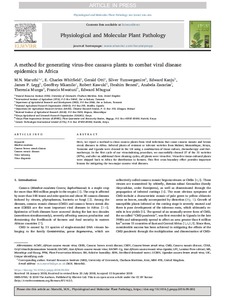| dc.contributor.author | Maruthi, M.N. |
| dc.contributor.author | Whitfield, E.C. |
| dc.contributor.author | Otti, G. |
| dc.contributor.author | Tumwegamire, S. |
| dc.contributor.author | Kanju, E. |
| dc.contributor.author | Legg, J.P. |
| dc.contributor.author | Mkamilo, G. |
| dc.contributor.author | Kawuki, R. |
| dc.contributor.author | Benesi, I. |
| dc.contributor.author | Zacarias, A. |
| dc.contributor.author | Munga, T. |
| dc.contributor.author | Mwatuni, F. |
| dc.contributor.author | Mbugua, E. |
| dc.date.accessioned | 2019-12-04T11:27:26Z |
| dc.date.available | 2019-12-04T11:27:26Z |
| dc.date.issued | 2019 |
| dc.identifier.citation | Maruthi, M.N., Whitfield, E.C., Otti, G., Tumwegamire, S., Kanju, E., Legg, J.P., ... & Mbugua, E. (2019). A method for generating virus-free cassava plants to combat viral disease epidemics in Africa. Physiological and Molecular Plant Pathology. |
| dc.identifier.issn | 0885-5765 |
| dc.identifier.uri | https://hdl.handle.net/20.500.12478/4934 |
| dc.description | Open Access Article; Published online: 14 Sept 2018. |
| dc.description.abstract | Here, we report a method to clean cassava plants from viral infections that cause cassava mosaic and brown streak diseases in Africa. Infected plants of resistant or tolerant varieties from Malawi, Mozambique, Kenya, Tanzania and Uganda were cleaned in the UK using a combination of tissue culture, chemotherapy and thermotherapy. In the first cycle of our virus-indexing procedure, we successfully cleaned 27 of the 31 varieties (87%), and after an additional three cleaning cycles, all plants were virus-free. Virus-free tissue-cultured plants were shipped back to Africa for distribution to farmers. This first cross-boundary effort provides important lessons for mitigating the two-major cassava viral diseases. |
| dc.description.sponsorship | Bill & Melinda Gates Foundation |
| dc.format.extent | 1-11 |
| dc.language.iso | en |
| dc.rights | CC-BY-4.0 |
| dc.subject | Cassava |
| dc.subject | Manihot Esculenta |
| dc.subject | Cassava Mosaic Virus |
| dc.subject | Virus Indexing |
| dc.subject | East Africa |
| dc.subject | Southern Africa |
| dc.title | A method for generating virus-free cassava plants to combat viral disease epidemics in Africa |
| dc.type | Journal Article |
| dc.description.version | Peer Review |
| cg.contributor.crp | Agriculture for Nutrition and Health |
| cg.contributor.crp | Roots, Tubers and Bananas |
| cg.contributor.affiliation | University of Greenwich |
| cg.contributor.affiliation | International Institute of Tropical Agriculture |
| cg.contributor.affiliation | Department of Agricultural Research and Development, Tanzania |
| cg.contributor.affiliation | National Agricultural Research Organization, Uganda |
| cg.contributor.affiliation | Department for Agricultural Research Services, Malawi |
| cg.contributor.affiliation | National Institute of Agricultural Research, Mozambique |
| cg.contributor.affiliation | Kenya Agricultural and Livestock Research Organization |
| cg.contributor.affiliation | Kenya Plant Inspectorate Services, Plant Quarantine and Biosecurity Station |
| cg.contributor.affiliation | Genetic Technologies International Limited, Kenya |
| cg.coverage.region | Africa |
| cg.coverage.region | East Africa |
| cg.coverage.region | Southern Africa |
| cg.coverage.country | Kenya |
| cg.coverage.country | Malawi |
| cg.coverage.country | Mozambique |
| cg.coverage.country | Tanzania |
| cg.coverage.country | Uganda |
| cg.creator.identifier | Silver Tumwegamire: 0000-0003-2820-6337 |
| cg.creator.identifier | Edward Kanju: 0000-0002-0413-1302 |
| cg.creator.identifier | James Legg: 0000-0003-4140-3757 |
| cg.researchtheme | BIOTECH & PLANT BREEDING |
| cg.researchtheme | PLANT PRODUCTION & HEALTH |
| cg.isijournal | ISI Journal |
| cg.authorship.types | CGIAR and developing country institute |
| cg.iitasubject | Cassava |
| cg.iitasubject | Plant Breeding |
| cg.iitasubject | Plant Health |
| cg.iitasubject | Plant Production |
| cg.journal | Physiological and Molecular Plant Pathology |
| cg.howpublished | Formally Published |
| cg.accessibilitystatus | Open Access |
| local.dspaceid | 101908 |
| cg.targetaudience | Scientists |
| cg.identifier.doi | http://dx.doi.org/10.1016/j.pmpp.2018.09.002 |

